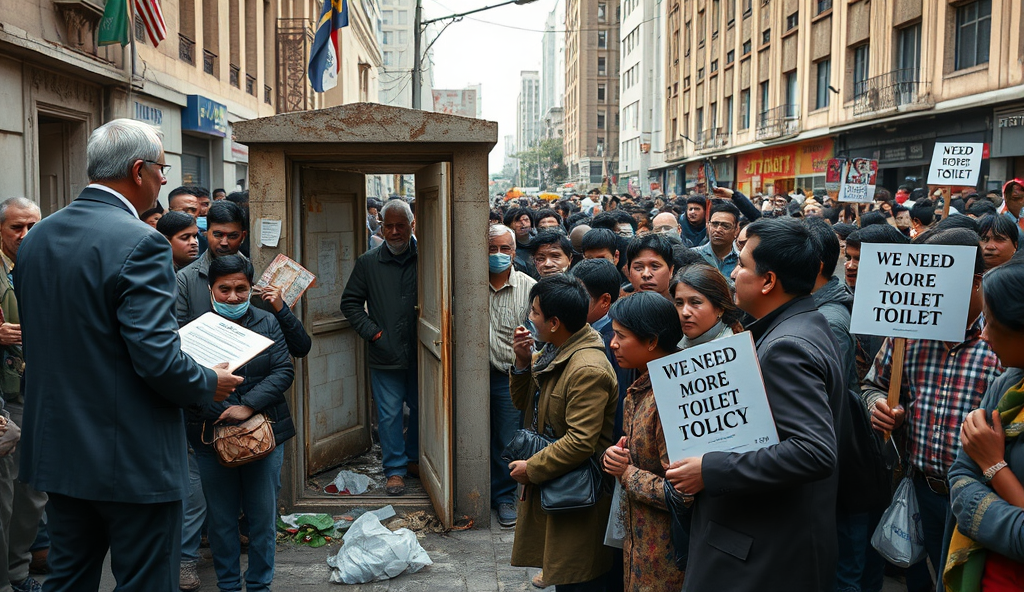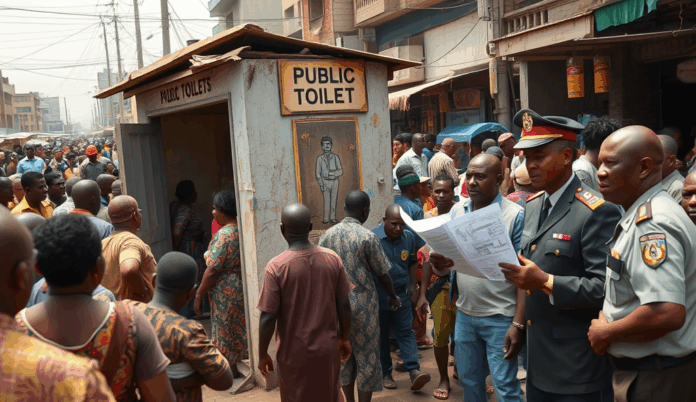Introduction: Understanding the Public Toilets Shortage in Nigeria
Nigeria faces a critical sanitation crisis, with only 29% of urban residents having access to improved public toilet facilities according to UNICEF. This shortage disproportionately affects high-traffic areas like markets and transport hubs, where inadequate facilities force many into open defecation, worsening public health risks.
The lack of public restrooms in Nigerian cities stems from decades of urban planning neglect and insufficient budget allocations for sanitation infrastructure. For instance, Lagos, Africa’s largest megacity, has fewer than 1,000 public toilets serving over 20 million residents, highlighting the severity of this challenge.
Understanding these systemic failures is crucial for local governments seeking sustainable solutions, which we’ll explore by examining the current state of public toilets across Nigeria. This analysis will reveal both immediate gaps and long-term opportunities for intervention.
Key Statistics

The Current State of Public Toilets in Nigeria
Nigeria faces a critical sanitation crisis with only 29% of urban residents having access to improved public toilet facilities according to UNICEF.
Nigeria’s public toilet infrastructure remains critically underdeveloped, with urban centers like Abuja and Port Harcourt reporting less than 40% coverage despite rapid population growth. A 2022 WaterAid report found that 60% of existing facilities are poorly maintained, often lacking water supply or functional waste disposal systems, exacerbating sanitation challenges in high-density areas.
Marketplaces and motor parks face the worst shortages, with Lagos Island’s Balogun Market having just four public toilets for over 500,000 daily visitors. This forces traders and commuters into unhygienic alternatives, directly contributing to the open defecation crisis highlighted in earlier sections.
The disparity between states is stark—while Edo launched 100 modern facilities in 2023, Kano struggles with dilapidated colonial-era structures. These uneven developments set the stage for examining the systemic challenges local governments face in bridging these gaps, which we’ll explore next.
Challenges Faced by Local Governments in Providing Public Toilets
A 2022 WaterAid report found that 60% of existing facilities are poorly maintained often lacking water supply or functional waste disposal systems exacerbating sanitation challenges in high-density areas.
Local governments grapple with chronic underfunding, with sanitation budgets averaging just 3% of total allocations despite Nigeria’s 47 million urban residents facing acute toilet shortages. Compounding this, rapid urbanization outpaces infrastructure planning—Lagos adds 600,000 inhabitants annually but constructs fewer than 50 public toilets per year.
Land disputes and bureaucratic bottlenecks delay projects, as seen in Kano where 12 planned facilities stalled for three years due to ownership conflicts. Maintenance costs also prove prohibitive, with WaterAid estimating ₦2.5 million monthly to sustain a single high-traffic facility—a figure exceeding most councils’ sanitation budgets.
These systemic barriers directly contribute to the health and environmental crises we’ll examine next, where inadequate facilities breed disease outbreaks and ecological damage. The disparity between states like Edo and Kano underscores how localized solutions must address these multifaceted challenges.
Health and Environmental Impacts of Inadequate Public Toilets
Local governments grapple with chronic underfunding with sanitation budgets averaging just 3% of total allocations despite Nigeria’s 47 million urban residents facing acute toilet shortages.
The sanitation crisis in urban areas of Nigeria manifests in recurrent cholera outbreaks, with 31,425 suspected cases reported across 22 states in 2021 alone according to NCDC data. Open defecation problems in Nigeria contribute to groundwater contamination, particularly in high-density areas like Lagos Island where fecal coliform levels exceed WHO limits by 300%.
Poor public hygiene infrastructure in Nigeria exacerbates respiratory and skin infections, accounting for 18% of outpatient visits in Abuja’s municipal clinics. Environmental degradation follows as untreated waste clogs drainage systems, worsening seasonal flooding—a 2022 study linked 40% of Lagos flood incidents to blocked sewers from improper waste disposal.
These health risks from toilet shortages in Nigeria underscore the urgency for solutions, paving the way for community engagement strategies we’ll explore next. The correlation between disease prevalence and sanitation access highlights why localized interventions must address both infrastructure and behavioral factors.
Community Engagement and Awareness for Public Toilet Usage
Behavioral change campaigns in Lagos slums reduced open defecation by 27% within 18 months demonstrating how community-led initiatives complement infrastructure development.
Behavioral change campaigns in Lagos slums reduced open defecation by 27% within 18 months, demonstrating how community-led initiatives complement infrastructure development. Local governments should partner with religious leaders and market associations, as seen in Kano’s successful “Clean Toilet, Healthy Life” program that increased public toilet usage by 40%.
Radio jingles and school sanitation clubs prove effective, with UNICEF reporting 35% higher adoption rates in communities using multimedia awareness strategies. These approaches address the behavioral factors driving Nigeria’s sanitation crisis while preparing communities for upcoming innovative toilet solutions.
Grassroots monitoring committees in Enugu improved maintenance accountability, showing how sustained engagement prevents the neglect plaguing 60% of government-built facilities. Such models create ownership essential for scaling the technological interventions we’ll examine next.
Innovative Solutions to Address Public Toilets Shortage
The Lagos State Government’s collaboration with private operators has delivered over 100 modern facilities with maintenance costs covered through user fees and corporate sponsorships ensuring long-term sustainability.
Building on successful behavioral interventions, Nigeria is now deploying cost-effective technologies like bio-digester toilets, which convert waste to biogas and have been piloted in Abuja markets with 90% user satisfaction. These systems address both the sanitation crisis in urban areas of Nigeria and energy needs, requiring 60% less water than conventional options.
Portable container toilets, adopted in Lagos traffic hotspots, serve 500 users daily per unit and reduce open defecation problems in Nigeria by providing temporary relief while permanent facilities are constructed. Such mobile solutions complement the grassroots monitoring models discussed earlier, ensuring maintenance through pay-per-use systems that fund operations.
Solar-powered sanitation hubs in Kano demonstrate how integrated designs can tackle inadequate toilet facilities across Nigeria while generating revenue from advertising spaces and charging stations. These innovations create a natural transition to exploring public-private partnerships, which we’ll examine next for their role in scaling these solutions sustainably.
Public-Private Partnerships for Sustainable Public Toilet Projects
Building on the success of innovative sanitation solutions like bio-digesters and solar-powered hubs, public-private partnerships (PPPs) offer a scalable model to address Nigeria’s public toilet shortage. The Lagos State Government’s collaboration with private operators has delivered over 100 modern facilities, with maintenance costs covered through user fees and corporate sponsorships, ensuring long-term sustainability.
These partnerships leverage private sector efficiency while maintaining public oversight, as seen in Abuja’s adoption of PPPs for market sanitation blocks, reducing government expenditure by 40%. Such models align with earlier grassroots monitoring systems, creating accountability through performance-based contracts tied to cleanliness standards and user satisfaction metrics.
With PPPs proving effective in urban centers, the next challenge lies in securing adequate funding mechanisms to expand these initiatives nationwide, a topic we’ll explore in the following section on budget allocation strategies.
Funding and Budget Allocation for Public Toilet Infrastructure
Strategic budget allocation remains critical for scaling the PPP model discussed earlier, with Lagos allocating 3.5% of its sanitation budget to toilet infrastructure in 2023, up from 1.8% in 2020. The federal government’s matching grant program has incentivized states like Kano to double their investments, leveraging funds from the Water Supply and Sanitation Collaboration Council.
Innovative financing mechanisms such as sanitation bonds, piloted in Rivers State, have raised ₦2.3 billion for 50 new facilities, while cross-subsidization models use commercial toilet revenues to fund community units. These approaches address the sanitation crisis in urban areas by creating sustainable funding streams beyond traditional government allocations.
As funding models evolve, robust policy frameworks must guide their implementation—a natural segue into examining regulatory structures that ensure equitable toilet provision across Nigerian communities.
Policy and Regulatory Frameworks to Support Public Toilet Provision
Effective policy frameworks are essential to sustain the financing innovations discussed earlier, with Nigeria’s 2021 National Sanitation Policy mandating at least one public toilet per 500 urban residents. States like Enugu have operationalized this through Local Government Sanitation Ordinances, imposing penalties on non-compliant property developers while offering tax rebates for PPP participants.
The federal government’s Public Toilet Standards (2022) prescribe minimum requirements for ventilation, water supply, and accessibility, addressing the sanitation crisis in urban areas through enforceable design guidelines. Lagos State’s recent amendment to its Environmental Protection Law now requires commercial hubs to allocate 2% of floor space for public toilets, creating 137 new facilities in Ikeja alone.
These regulatory measures provide the foundation for scaling successful initiatives, as seen in the case studies from Rivers and Kano that will be examined next. By aligning enforcement with incentives, policymakers can transform isolated successes into nationwide solutions for Nigeria’s toilet scarcity.
Case Studies of Successful Public Toilet Initiatives in Nigeria
Rivers State’s PPP model with private operators has increased public toilet access by 40% in Port Harcourt since 2020, leveraging the federal government’s Public Toilet Standards for quality control. The initiative combines user fees with government subsidies, ensuring sustainability while addressing the sanitation crisis in urban areas through well-maintained facilities.
Kano’s community-led approach trained 120 local artisans to build low-cost toilets using standardized designs, creating 85 facilities across 15 high-density neighborhoods. This aligns with Nigeria’s 2021 National Sanitation Policy by empowering residents to tackle open defecation problems through ownership and maintenance committees.
Lagos’s enforcement of its 2% floor space rule has not only expanded infrastructure but also improved hygiene standards through scheduled cleaning audits, a practice the next section will explore in depth. These cases demonstrate how localized solutions can scale nationally when supported by clear policies and stakeholder engagement.
Monitoring and Maintenance Strategies for Public Toilets
Building on Lagos’s successful cleaning audits, routine maintenance protocols must integrate real-time feedback systems like mobile apps used in Abuja, where 92% of reported issues are resolved within 48 hours. This complements Rivers State’s PPP model by ensuring private operators meet contractual hygiene benchmarks through unannounced inspections tied to subsidy releases.
Kano’s maintenance committees demonstrate how low-cost solutions like rainwater harvesting can sustain facilities during water shortages, reducing downtime by 60% in pilot areas. Such localized adaptations should be standardized in Nigeria’s 2021 National Sanitation Policy to address urban planning issues with public toilets nationwide.
As shown by these models, combining technology, community oversight, and policy enforcement creates resilient systems—a foundation for the concluding call to action targeting local government officials. The next section will outline specific steps to operationalize these strategies across Nigerian municipalities.
Conclusion: A Call to Action for Local Government Officials
The sanitation crisis in urban areas of Nigeria demands immediate intervention, with 47 million Nigerians still practicing open defecation due to inadequate toilet facilities. Local governments must prioritize budget allocations for public restrooms, leveraging partnerships with private operators as seen in Lagos’s recent PPP model.
Addressing the health risks from toilet shortages requires innovative urban planning, including modular designs tested in Kano’s high-density neighborhoods. By adopting these solutions, councils can reduce disease outbreaks linked to poor public hygiene infrastructure.
Your leadership can transform Nigerian communities suffering from toilet scarcity into models of sustainable sanitation. The next steps involve mobilizing community stakeholders and implementing the strategies discussed throughout this policy watch.
Frequently Asked Questions
How can local governments fund public toilet projects without straining existing budgets?
Explore PPP models like Lagos State’s corporate sponsorship program and consider sanitation bonds as piloted in Rivers State to raise dedicated funds.
What low-cost maintenance strategies work best for public toilets in high-traffic areas?
Adopt Kano’s rainwater harvesting systems and community monitoring committees to reduce water costs and ensure accountability through local oversight.
How can we enforce public toilet standards in markets and transport hubs?
Implement Lagos-style 2% floor space regulations with tax incentives for compliance and penalties for violations to drive private sector participation.
What quick-win solutions can address immediate public toilet shortages in urban slums?
Deploy portable container toilets like Lagos’s traffic hotspot units and bio-digester systems that require minimal infrastructure for rapid installation.
How do we measure the impact of new public toilet facilities on community health?
Track cholera case reductions and outpatient visits for sanitation-related illnesses using NCDC’s reporting templates to quantify health improvements.


